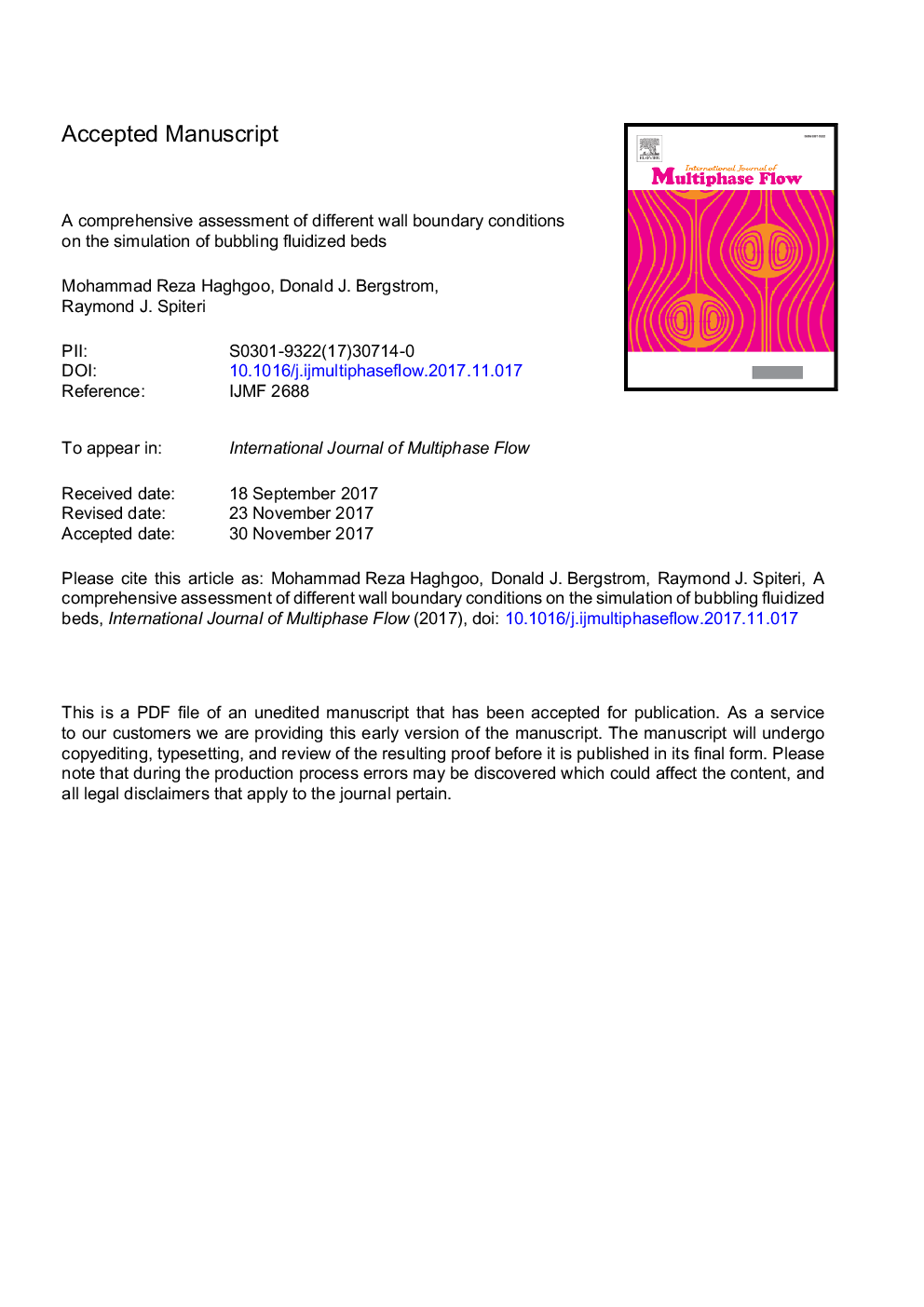| کد مقاله | کد نشریه | سال انتشار | مقاله انگلیسی | نسخه تمام متن |
|---|---|---|---|---|
| 7060207 | 1458479 | 2018 | 28 صفحه PDF | دانلود رایگان |
عنوان انگلیسی مقاله ISI
A comprehensive assessment of different wall boundary conditions on the simulation of bubbling fluidized beds
ترجمه فارسی عنوان
ارزیابی جامع از شرایط مرزی دیوارهای مختلف بر روی شبیه سازی تختهای مایع ذوب شده
دانلود مقاله + سفارش ترجمه
دانلود مقاله ISI انگلیسی
رایگان برای ایرانیان
کلمات کلیدی
شرایط مرزی ذرات، بستر سیال، استرس مقیاس حل، مخلوط کردن مناطق، شبیه سازی عددی، دو مدل مایع،
ترجمه چکیده
شرایط مرزی ذرات و ذرات مختلف موجود در ادبیات وجود دارد که برای سرعت لغزش ذرات و جریان انرژی دانه در دیواره حساب می شود. با این حال، هنوز روشن نیست که چگونه این شرایط مرزی دیوار مختلف بر رفتار جریان شبیه سازی تاثیر می گذارد، و نه روشن است که واقع بینانه ترین. برای این منظور، سه شرایط مرزی ذرات ذره ای مورد بررسی قرار می گیرند تا بتوانند توانایی آنها را برای پیش بینی پویایی جریان یک گاز ذرات متراکم در داخل یک تخت بطری سه بعدی با استفاده از مدل دو مایع بررسی کنند. برای درک اینکه چگونه مدل های دیوار بر ویژگی های ساختاری جریان تاثیر می گذارند، تجزیه و تحلیل کمی بر روی برخی از جنبه های مهم مکانیک تابیده شدن تخت انجام شده است که در ادبیات نسبتا کمی توجه کرده اند. بر این اساس، اثر هر مدل دیوار بر روی میدان سرعت، آمار حباب سه بعدی، نوسانات فشار گاز و تنش رینولدز مقیاس ذرات بررسی شده است. همچنین، پیش بینی مناطق مخلوط غالب درون بستر شناسایی و تجسم می شود تا کمی عملکرد تخت را توصیف کند. یافته شده است که حباب های پر انرژی بیشتر به سطح پایین تر از دمای گرانول، یک تخت کم عمق و مناطق بیشتر مخلوط در داخل بستر منجر می شود. همچنین مشاهده می شود که در مورد تپه های حباب، اختلاط ناشی از تنش طبیعی رینولدز بسیار قوی تر از ناشی از تنش برشی رینولدز است. به طور کلی، جریان های پیش بینی شده توسط سه مدل دیوار از نظر ساختاری مشابه هستند. با این حال، برخی از ویژگی های خاص می توانند به روش سیستماتیک متفاوت باشند که می تواند به اثر شرایط مرزی دیوار بر رفتار حباب رجوع شود. نتایج عددی روی داده های آزمایشی منتشر شده معتبر و نشان دهنده نقش مهمی در وضعیت مرز دیواره ذرات است.
موضوعات مرتبط
مهندسی و علوم پایه
مهندسی شیمی
جریان سیال و فرایندهای انتقال
چکیده انگلیسی
There are different particle-wall boundary conditions available in the literature to account for the particle slip velocity and the granular energy flux at the wall. However, it is not yet clear how these different wall boundary conditions affect the simulated flow behavior, nor is it clear which are the most realistic. To this end, three different particle-wall boundary conditions are examined to assess their ability to predict the dynamics of a dense gas-particle flow inside a three-dimensional bubbling bed, using the two-fluid model. To understand how the wall models affect structural features of the flow, a quantitative analysis is performed on some important aspects of the mechanics of bubbling beds that have received relatively little attention in the literature. Accordingly, the effect of each wall model on the velocity field, three-dimensional bubble statistics, gas-pressure fluctuations, and particle resolved-scale Reynolds stress are investigated. Also, the predicted dominant mixing regions inside the bed are identified and visualized in order to quantitatively describe the bed performance. It is found that the more energetic bubbles result in a lower level of granular temperature, a less-expanded bed, and more extensive mixing regions inside the bed. It is also observed that, in the case of bubbling beds, the mixing caused by the Reynolds normal stress is much stronger than that caused by the Reynolds shear stress. Overall, the flows predicted by the three wall models are structurally similar. However, some specific features can differ in a systematic way that can be tracked to the effect of wall boundary condition on the bubble behavior. The numerical results are validated against published experimental data and demonstrate the significant role of the particle-wall boundary condition.
ناشر
Database: Elsevier - ScienceDirect (ساینس دایرکت)
Journal: International Journal of Multiphase Flow - Volume 99, February 2018, Pages 500-511
Journal: International Journal of Multiphase Flow - Volume 99, February 2018, Pages 500-511
نویسندگان
Mohammad Reza Haghgoo, Donald J. Bergstrom, Raymond J. Spiteri,
